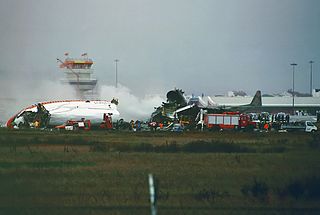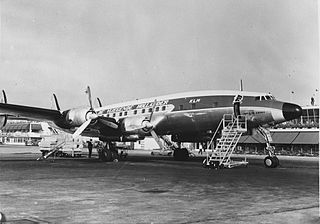
The Tenerife airport disaster occurred on 27 March 1977, when two Boeing 747 passenger jets collided on the runway at Los Rodeos Airport on the Spanish island of Tenerife. The accident occurred when KLM Flight 4805 initiated its takeoff run in dense fog, colliding with the right side of Pan Am Flight 1736 still on the runway. The impact and the resulting fire killed all 248 people on board the KLM plane and 335 of the 396 people on board the Pan Am plane, with only 61 survivors in the front section of the latter aircraft. With a total of 583 fatalities, the disaster is the deadliest accident in aviation history.

Shannon Airport is an international airport located in County Clare in Ireland. It is adjacent to the Shannon Estuary and lies halfway between Ennis and Limerick. With almost 2 million passengers in 2023, the airport is the third busiest airport in the Republic of Ireland, and the fifth busiest on the island.

A KLM Lockheed L-049 Constellation airliner crashed into high ground near Glasgow Prestwick Airport, Scotland, on 20 October 1948; all 40 aboard died. A subsequent inquiry found that the accident was likely caused by the crew's reliance on a combination of erroneous charts and incomplete weather forecasts, causing the crew to become distracted and disoriented in the inclement conditions.

Gander International Airport is located in Gander, Newfoundland and Labrador, Canada, and is operated by the Gander International Airport Authority. Canadian Forces Base Gander shares the airfield but is a separate entity from the airport. The airport is sometimes referred to as the "Crossroads of the World", and is classified as an international airport by Transport Canada.

Martinair Flight 495 was a McDonnell Douglas DC-10 operated by Dutch airline Martinair, that crash-landed in severe weather conditions at Faro Airport, Portugal on 21 December 1992. The aircraft carried 13 crew members and 327 passengers, mainly holidaymakers from the Netherlands. The crash killed 54 passengers and 2 crew members; 106 of the other occupants were badly injured.

In aviation, a water landing is, in the broadest sense, an aircraft landing on a body of water. Seaplanes, such as floatplanes and flying boats, land on water as a normal operation. Ditching is a controlled emergency landing on the water surface in an aircraft not designed for the purpose, a very rare occurrence. Controlled flight into the surface and uncontrolled flight ending in a body of water are generally not considered water landings or ditching, but are considered accidents. Most times, ditching results in aircraft structural failure.

KLM Flight 607-E was an international scheduled flight that crashed on 14 August 1958, on takeoff from Shannon Airport, Ireland. The aircraft was a Lockheed Super Constellation. All 99 on board died, making the crash the deadliest civil aviation disaster involving a single aircraft at the time, and the deadliest crash involving the Lockheed Constellation series, until the disappearance of Flying Tiger Line Flight 739 in 1962.

El Trompillo Airport is located in the south part of Santa Cruz, Bolivia, about 2 km away from the central plaza.
Air France has been in operation since 1933. Its aircraft have been involved in a number of major accidents and incidents. The deadliest accident of the airline occurred on June 1, 2009, when Air France Flight 447, an Airbus A330-203, flying from Rio de Janeiro to Paris crashed into the Atlantic Ocean with 228 fatalities. A selected list of the most noteworthy of these events is given below.

British Overseas Airways Corporation (BOAC) was the British state-owned airline created in 1939 by the merger of Imperial Airways and British Airways Ltd. It continued operating overseas services throughout World War II. After the passing of the Civil Aviation Act 1946, European and South American services passed to two further state-owned airlines, British European Airways (BEA) and British South American Airways (BSAA). BOAC absorbed BSAA in 1949, but BEA continued to operate British domestic and European routes for the next quarter century. The Civil Aviation Act 1971 merged BOAC and BEA, effective 31 March 1974, forming today's British Airways.

US-Bangla Airlines Flight 211 was a scheduled international passenger flight from Hazrat Shahjalal International Airport in Dhaka, Bangladesh, to Tribhuvan International Airport in Kathmandu, Nepal, that crashed on 12 March 2018 while landing, killing 51 of the 71 people aboard. The aircraft, a 76-seat Bombardier Q400 operated by US-Bangla Airlines, burst into flames after the crash. The 20 surviving passengers were badly injured from the impact and the fire. It remains the deadliest aviation disaster involving a Bangladeshi airline, and the deadliest incident involving a Bombardier Dash 8 Q400.










